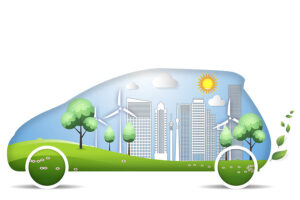“Imagination is more important than knowledge. For knowledge is limited, whereas imagination embraces the entire world, stimulating progress, giving birth to evolution,” said Albert Einstein. Evolution is something, a necessity for the betterment of the human population. All of us are sustained in either developing or developed world, which is evolving over a while.
Development of newer technologies along with the pieces of machinery to make our daily tasks easier are on their way. One of the important aspects of our day-to-day lives is the automotive industry having electric vehicles (EVs) as their relatively innovative concept in the world of transportation. They are vehicles that partly or fully run on electric power.

About EV’s.
Electric vehicles (EVs) are automobiles using one or more electric motors. These motors may be driven through a collector system by electricity, or maybe self-enclosed with solar or fuel cells, battery, or an electric generator converting the fuel to electricity. Due to this reason, EVs may sometimes be recognized as battery electric vehicles.
They include all forms of transport comprising buses, cars, trains, underwater transport, aircraft, etc. It was since the mid-19th century when ease of operation together with a comfort level was found achievable using electric vehicles, hence was preferable over the gasoline-based vehicle.
A brief timeline.
- 1827- Ányos Jedlik, a Hungarian priest built the first basic electric motor consisting of a rotor, stator, and commutator which he used to power a tiny car.
- 1835- A small-scale electric car was built by Sibrandus Stratingh, professor at the University of Groningen, the Netherlands.
- 1832-39- A carriage consisting of non-rechargeable primary power cells was developed by Robert Anderson, a Scottish inventor.
- 1835- A toy electric train, run by a primitive electric motor was assembled by Thomas Davenport.
- 1838- An electric steam engine, got a speed of four miles per hour (6 km/h) was built by Robert Davidson.
- 1840- A patent in England was granted for the use of electric trains.
- 1847- A similar patent was issued to Lilley and Colten in America.
- 1900s-First mass-produced electric vehicles manufactured in America.
- Early 20s-till date –Experimentation is going on for various modes of electric transport systems.
Some key components of EV’s.
EV’s use an enormous power battery to supply the electric motor with power. It is essential to keep this battery source plugged into charging equipment, known as electric vehicle supply equipment (EVSE).
Since these vehicles run on electricity, neither they emit any exhaust nor do they contain the distinctive liquid fuel components, for instance, a fuel pump or fuel tank. Other important components include:
- Battery(a backup source): An additional battery provides electricity to control vehicle accessories in an electric vehicle.
- DC converter: It converts high-voltage DC power from the power battery to low-voltage DC power that is needed to run vehicle accessories and recharge the supporting battery.
- A charging port: It lets the vehicle link to an outer power supply to charge the traction battery box.
- Electric power motor: This motor drives the wheels of EVs using power from the power battery box.
- Cooling system: It lowers down the temperature range of the engine, power electronics, electric motor, and other components.
- Power battery box: This box stores electricity to be used by the electric power motor.
- Power controller: This unit bring about the flow of electrical energy delivered by the power battery. Also, it controls the speed of the electric power motor and the torque produced by it.
- Onboard charger: Converts AC electricity supplied from charging port to DC power for charging the power battery. This device also interconnects with the charging equipment and observes battery readings for voltage, temperature, current, and state of charge while charging the box.
Kinds of EVs.
There are two main types of electric vehicles (EVs):
- Fully electric.
- Plug-in hybrids.
Fully electric vehicles (FEV)/ Battery Electric Vehicles (BEV).
Battery electric vehicles have around 99% fewer movable parts that require maintenance in comparison to that of internal combustion locomotives.
Advantages of a BEV:
- No emission of exhaust and spark plugs
- Produce very little to no noise
- No burning of fossil fuels (petrol/diesel)
- Uses rechargeable bateries
Fully electric vehicles can be easily recharged at home overnight to provide enough range for average outings. Though, the fuel cells may require frequent charging before reaching the destination for the longer journeys.
The charging time ranging from 30 minutes to 12 hours entirely depends on the speed of the charging station and the size of the battery contained in the vehicle.
Plug-in hybrid electric vehicles (PHEVs).
Instead of depending on the electric motor, these vehicles offer a partial use of battery and diesel (or petrol) power. This characteristic of PHEVs allows us to switch to traditional fuels in absence of any charging points to recharge the battery for comfortable long journeys.
BEVs are more advantageous over PHEVs due to the following reasons:
- Requires more maintenance
- Produces the engine noise
- Polluting the environment with undesirable emissions
- Expensive
- Small battery packs reducing the speed of charging and the range of journey to be covered.
Benefits of EVs.
Environment friendly- Sine EVs use little or no fossil fuels such as petrol or diesel, they do not cause even slighter pollution, henceforth considering them eco-friendly vehicles.
More-convenient- One can easily recharge the electric vehicle at the household powerpoint, without running to the fuel station now and then.
No discharge of harmful gases- Electric vehicles run on electrically powered engines, hence are fully ecological. As they run on a clean energy source, do not release poisonous gases or smoke into the environment. They help you contribute to a green, clean and healthy environment. These vehicles are significantly better than hybrid vehicles releasing toxic gases while running.
Cost-effectiveness- As electronic vehicles have fewer moving parts for maintenance purposes, their running costs are comparatively lower than that of fuel vehicles.
Safer drive– Like other fuel-powered vehicles, EVs also go through a similar ability and testing protocol. Since they have a lower center of gravity, are safer to use, providing them much more stability on the road. Further, in case an accident occurs, one can expect a sudden cut down of electricity supply from the battery, preventing the passengers from serious injuries. The chances to explode are fewer in absence of any burnable fuel or gas.
Battery use- Batteries play an important role in an electric vehicle. They are usually made up of lithium, having their life and costs improving each year. However, the cost of batteries is estimated to reduce even more with the improved technologies.
Low maintenance service– Electric vehicles run on electrically powered engines that cut down the requirement of lubrication of the engines. It is due to the absence of a gas engine, you do not need to get it serviced so frequently as needed to be done for a standard gasoline-powered vehicle.
Limitations of EVs
Driving range and speed– Many of the electric vehicles are limited by their speed and range covering roughly 50-100 miles on a full recharge which is comparatively lower than the fuel-based vehicles.
Increased electricity bill– It is better to research all the features of the electric vehicle you want to purchase as some EVs may consume a lot of electricity, leading you to an unwise investment.
Availability of recharging points- As many of the electric fueling stations are still under development stages, finding a recharging point for your vehicle may get a little harder especially during long trips. In such cases, there are more chances of you getting stuck at the place where you are.
Replacement of battery– The batteries fitted in EVs may require a replacement after every 4-12 years depending on the battery and its usage.
Silence- a drawback- Since people like to hear the sound to know if any other vehicle is coming behind them, silence can be a limitation. Electric vehicles are noiseless, hence can lead to road accidents.
List of some top companies manufacturing EVs.
1. Tesla (US)
2. BYD (China)
3. Nissan Motors (Japan)
4. Volkswagen AG (Germany)
5. Mahindra Electric (India)
6. Tata Motors (India)
7. Hero Electric (India)
8. BMW Group (Germany)
Recent advancements.
1. May 2019- A new Ioniq electric version with an increased battery of 38.3 kWh (from 28kWh) was showcased by the Hyundai group.
2. November 2019- e3 electric sedan was launched by BYD, China. It was developed with two battery options, 35.2 kWh and 47.3 kWh and a single 70 kW electric motor having a range of around 252 miles.
3. March 2020- the 2nd generation 330e and 330e xDrive was launched by BMW in the market of North American. The vehicle had a 12 kWh battery and an all-electric range of 20-22 miles.
4. July 2020- Han, the electric vehicle was launched in BEV and PHEV versions with two battery options by BYD, China.
5. December 2020- The Leaf model was launched by Nissan Motors in the US. The vehicle had a choice of battery between 40 kWh and 62 kW with mileage ranging between ranges between 149 miles and 226 miles per charge.
6. April 2021- The 7 seater EV ID.6 Crozz and ID.6 X produced along with FAW and SAIC in China was disclosed by Volkswagen.
7. April 2021- Toyota revealed the new LS and Mirai models in japan. The vehicle comes with advanced driving assist technology.











